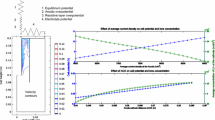Abstract
Ionic mass transfer in a parallel plate electrochemical cell having a flow entrance representative of practical industrial cells has been studied under laminar flow condition using the ferri- and ferrocyanide redox couple. The working electrode was segmented so that local mass transfer coefficient could be measured. The mass transfer coefficients, measured for the entrance region of the cell, which is defined as the region where both hydrodynamic and concentration boundary layers are developing simultaneously, are correlated and compared with results from other studies. For the electrode section beyond the entrance region, where the flow is fully developed but the concentration boundary layer continues to grow, a correction term is added to the electrode dimension parameter in the Graetz number. In this way the Leveque equation can still be used to correlate the local mass transfer coefficient. The value of the correction term is calculated by matching the downstream mass transfer boundary layer thickness to that of a Leveque-type cell. This scheme improves substantially the convergence of the experimental data correlation and results in good agreement with the Leveque equation.
Similar content being viewed by others
Abbreviations
- B :
-
width of electrode (cm)
- d e :
-
equivalent diameter of cell, 2SB/(B +S) (cm)
- D :
-
diffusion coefficient of ferricyanide (cm2 s−1)
- k y :
-
local mass transfer coefficient aty (cm s−1)
- k L e :
-
local mass transfer coefficient aty =L e (cm s−1)
- k y′ :
-
local mass transfer coefficient aty=y′ (cm s−1)
- k av :
-
average mass transfer coefficient over electrode lengthL (cm s−1)
- l :
-
concentration boundary layer thickness in developing flow cell (cm)
- l′ :
-
concentration boundary layer thickness in Leveque-type cell (cm)
- L :
-
electrode length (cm)
- L e :
-
hydrodynamic entrance length (cm)
- S :
-
gap distance between electrode and opposite wall (cm)
- U av :
-
average electrolyte flow velocity (cm s−1)
- x 0 :
-
the length of leading inert section of electrode (cm)
- X :
-
x 0 +L (cm)
- y :
-
distance from beginning of active mass transfer section in the channel (cm)
- y′ :
-
distance equivalent toL e in Leveque-type of cell (cm)
- y i :
-
distance from mass transfer starting point in the channel to the upstream edge of electrode segmenti (cm)
- y i+1 :
-
distance from mass transfer starting point in the channel to the downstream edge of electrode segmenti (cm)
- Y :
-
modified electrode coordinate (cm)
- Y i :
-
y i −L e +y′ (cm)
- Y i+1 :
-
y i+1 −L e +y′ (cm)
- γ:
-
respect ratio,S/B
- Γ:
-
ionic strength
- ρ:
-
density of electrolyte (gcm−3)
- μ:
-
viscosity of electrolyte (poise)
- Gz :
-
Graetz number,Sc Re d e/y
- Re :
-
Reynolds number, ρU av d e/μ
- Re L :
-
Reynolds number, ρU av L/μ
- Re X :
-
Reynolds number, ρU av X/μ
- Sc :
-
Schmidt number, μ/ρD
- Sh :
-
Sherwood number,k yde/D
- Sh L :
-
Sherwood number,k av L/D
- Sh X :
-
Sherwood number,k av X/D
- av:
-
average
- e:
-
equivalent or entrance
- y :
-
electrode length coordinate
References
G. Wranglen and O. Nilsson,Electrochim. Acta 7 (1962) 121.
C. W. Tobias and R. G. Hickman,Z. Phys. Chem. (Leipzig),229 (1965) 145.
A. Palade de Iribarne, S. L. Marchiano and A. J. Arvia,Electrochem. Acta 15 (1970) 1827.
D. J. Pickett and B. R. Stanmore,J. Appl. Electrochem. 2 (1972) 151.
D. J. Pickett and K. L. Ong,Electrochim. Acta 19 (1974) 875.
M. A. Leveque,Ann. Mines 13 (1928) 201, 305 and 381.
L. Graetz,Ann. Phys. Chem. 25 (1885) 337.
R. B. Bird, W. E. Stewart and E. N. Light, ‘Transport Phenomena’, John Wiley & Sons, New York (1960) p. 607.
E. J. Rudd, inProceedings of the 33rd International Power Sources Symposium, The Electrochemical Society, Pennington, NJ (1988).
K.-Y. Chan and R. F. Savinell, Abstract No. 12, P17–18, ‘Extended Abstract’,89-1, Electrochem. Soc. Inc., Pennington, N.J.
Personal Communication with E. J. Rudd of Eltech System Corp. referring to Progress Reports for the Department of Energy Contract SNLA 02-8199 (1988).
A. Vogel, ‘Textbook of Quantitative Inorganic Analysis’, 4th ed., Longman Scientific & Technical, Harmondsworth (1978) p. 385.
W. J. Blaedal and V. W. Meloche, ‘Elementary Quantitative Analysis, Theory and Practice., 2nd ed., Harper & Row, New York (1963) p. 850.
‘Caustic Potash Handbook’, published by Diamond Shamrock Corp.
C. S. Lin, E. B. Denton, H. S. Gaskill and G. L. Putnam,Ind. Eng. Chem. 43 (1951) 2137.
S. L. Gordon, J. S. Newman and C. W. Tobias,Ber. Bunsenges. Phys. Chem. 70 (1966) 414.
A. J. Arvia, S. L. Marchiano and J. J. Podesta,Electrochim. Acta 12 (1967) 259.
D. J. Pickett, ‘Electrochemical Reactor Design’, Elsevier Scientific, New York (1977) pp. 133, 135, 140.
J. R. Selman and C. W. Tobias, in ‘Advances in Chemical Engineering’, Vol. 10 (edited by T. B. Drew, G. R. Rokelet, J. W. Hooper, Jr. and T. Vermeulen), Academic Press, New York (1978).
J. Newman, in ‘Electroanalytical Chemistry’, Vol. 6 (edited by A. J. Bard), Marcel Dekker, New York (1973).
R. S. Brodkey, ‘The Phenomena of Fluids Motion’, Addison-Wesley (1967), p. 129.
L. S. Han,J. Appl. Mech. 27 (1960) 403.
Author information
Authors and Affiliations
Rights and permissions
About this article
Cite this article
Qi, J., Savinell, R.F. Mass transfer in a laminar-flow parallel plate electrolytic cell with simultaneous development of velocity and concentration boundary layers. J Appl Electrochem 20, 885–892 (1990). https://doi.org/10.1007/BF01019561
Received:
Revised:
Issue Date:
DOI: https://doi.org/10.1007/BF01019561




